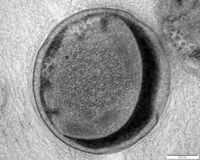Colony collapse disorder
Background
Colony collapse disorder (CCD) is a poorly understood phenomenon where large-scale, unexplained losses of adult worker honey bee colonies result in the bee colony. As of today, it is believed that many factors together is contributing to the underlying cause of the phenomenon. [6][10]. The phenomenon is often coupled with abnormal decrease in bee population and could be identified throughout the history of bee keeping. The phenomenon has been associated to various names including autumn collapse, spring dwindle, disappearing disease, May disease, and fall dwindle disease. However, the phenomenon was renamed as colony collapse disorder in late 2006 after considering previous names was not reflecting the nature of the condition. [6]. Recent studies have tried to link microbial contributions to this phenomenon. Virus such as Israeli acute paralysis virus and Kashmir bee virus have been suspected to play an important role in this phenomenon. [6].
Characteristics
1. Rapid loss of adult workers bees and large amounts of capped brood within the colony. The bodies of the dead bees are not found in the colonies or in front of the colonies.[6]
2. Food storage are present, both honey and bee bread.[6]
3. Queen bee is present. A colony cannot be classified as suffering CCD if the queen is not found within the colony. Rather, the colony dying because there is no queen, which is not considered CCD.[6]
4. There is no damaging levels of the mite Varroa destructor and/or the Nosema spp. at the time of collapse, and there is a delayed invasion by other hive parasite. [6]
Distribution
Although many countries around the world experience large decrease in the bee population, only a few countries has documented that the decrease is associated with CCD.
North America
The only country where CCD has been documented in North America is the United States. Multiple incidents of abnormal decrease in bee hives were associated with CCD. Colony mortality during the 2006/2007, 2007/2008, and 2008/2009 winters in the US was 32% [7], 36% [8], and 29% [9], respectively.
Europe
Europe has experienced large scale decrease in bee population in the past years, the population decline was reported from Belgium, France, United Kingdom, the Netherlands, Greece, Italy, Portugal, Spain, and Germany.[8] The reports from the European Food Safety Authority (EFSA) in 2007 and 2008 have indicated that the bee population dropped by around 30% in the United Kingdom, meanwhile the bee population in Italy experienced a mortality rate between 40–50% . The German national association of beekeepers reported a 40% loss of the honey bee colonies in 2009.[8], The Switzerland government also reported that about 50% of the bee population had not survived the winter at the end of May 2012. Other than a case study reported in Switzerland, which associated the decline with CCD [3], , the cause of large decline in bee population is not definite. Many countries in Europe attributed decline to the parasites such as Varroa destructor and bad weathers which prevented the bees from gathering food.

